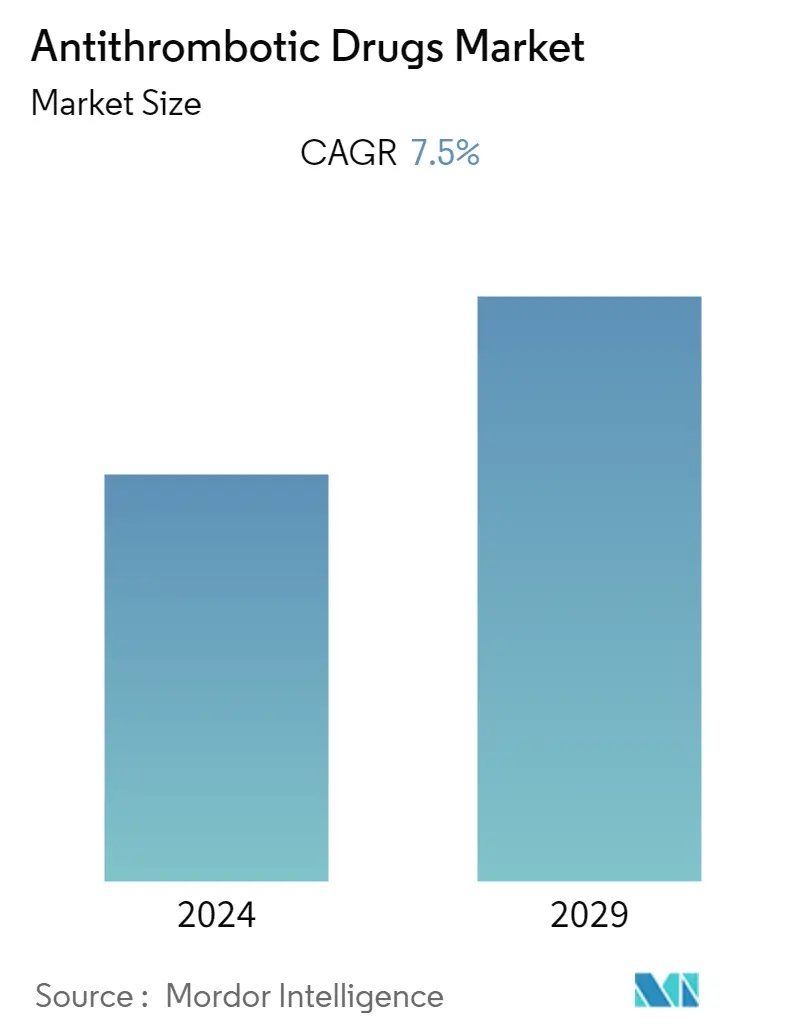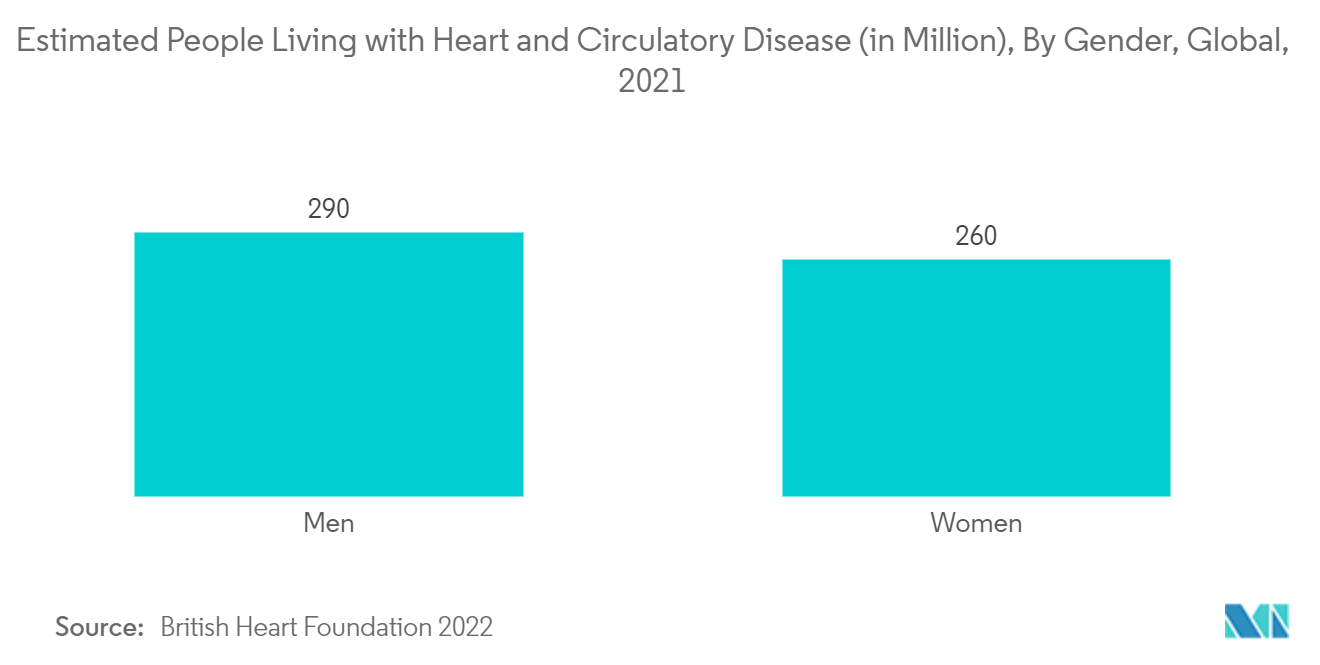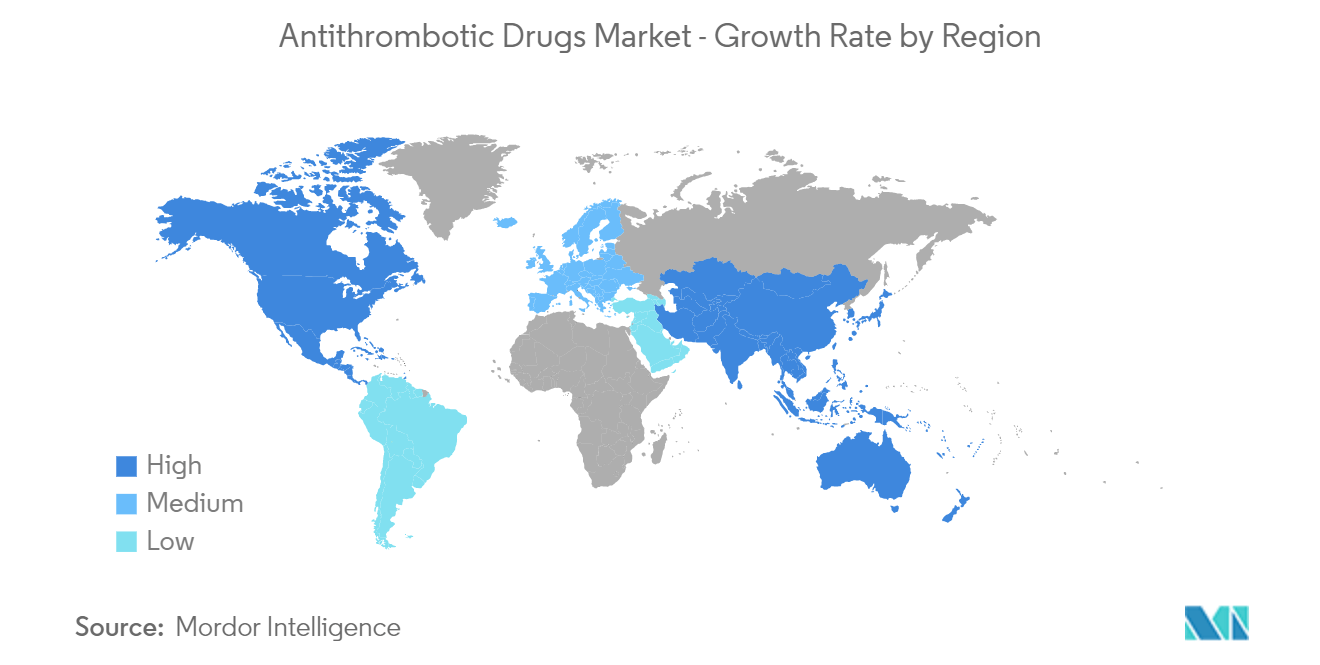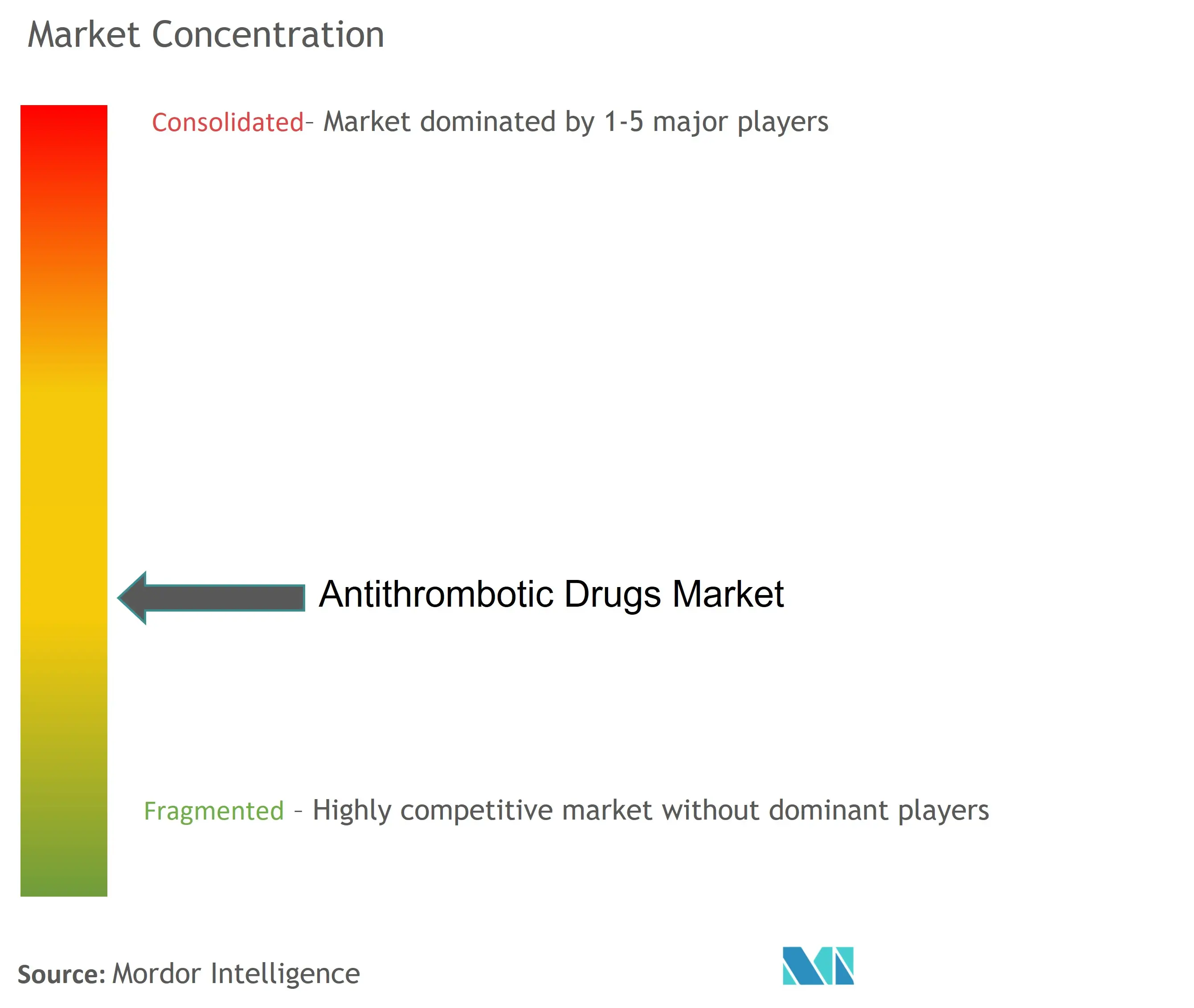Antithrombotic Drugs Market Size

| Study Period | 2020 - 2029 |
| Base Year For Estimation | 2023 |
| Forecast Data Period | 2024 - 2029 |
| CAGR | 7.50 % |
| Fastest Growing Market | Asia-Pacific |
| Largest Market | North America |
Major Players
*Disclaimer: Major Players sorted in no particular order |
Antithrombotic Drugs Market Analysis
The antithrombotic drug market is projected to register a CAGR of 7.5% during the forecast period.
The COVID-19 pandemic imposed a high burden on the healthcare industry, increasing its focus on providing better healthcare facilities, monitoring devices, services, and teleconsultation. For instance, according to the NCBI article published in June 2021, more than half (53%) of the countries surveyed partially or completely disrupted services for hypertension treatment, and 31% for cardiovascular emergencies. Thus, the reduction in cardiovascular care services during the initial stages of the pandemic due to the strict lockdown procedures imposed by various governments had a significant impact on the market's growth during the pandemic period. However, the relaxation of stringent regulations during the post-pandemic period is expected to restore market growth over the next five years.
Certain factors that are propelling the growth of the market are the increase in the prevalence of cardiac and hereditary diseases and the growing demand for novel oral anticoagulants, coupled with the ageing population.
The rising burden of cardiac and hereditary diseases is the major factor driving demand for the antithrombotic drug market. For instance, the British Heart Foundation (BHF) data published in January 2022 reported that in 2021, the most common heart conditions affected globally were coronary (ischemic) heart disease (global prevalence estimated at 200 million), peripheral arterial (vascular) disease (110 million), stroke (100 million), and atrial fibrillation (60 million). The report also mentioned that the prevalence of heart and circulatory diseases in North America was 46 million, in Europe it was 99 million, in Africa it was 58 million, in South America it was 32 million, and in Asia and Australia it was 310 million. Such an increase in cardiovascular disease across the world is expected to increase the demand for antithrombotic drugs, thereby propelling market growth.
In addition, the increasing incidence and prevalence of diabetes mellitus and obesity among the population are also contributing to the demand for antithrombotic drugs as these patients are more susceptible to atherosclerotic cardiovascular events. In such cases, antiplatelet drugs are the secondary prevention method that reduces the risk of atherosclerotic cardiovascular events and their adverse prognostic consequences. For instance, according to the 2022 statistics published by the International Diabetes Federation in the 10th edition of 2021, in Germany, 6,199.9 thousand people lived with diabetes in 2021. Thus, an increasing number of people living with diabetes are at high risk of developing cardiovascular diseases, which is expected to increase the demand for antithrombotic drugs, thereby propelling market growth.
However, the stringent regulatory policies, high cost, and side effects of antithrombotic drugs are likely to restrain market growth over the forecast period.
Antithrombotic Drugs Market Trends
This section covers the major market trends shaping the Antithrombotic Drugs Market according to our research experts:
Anticoagulants Segment is Expected to Register a Significant CAGR During the Forecast Period
Anticoagulants, also called blood-thinning drugs, are used to treat and prevent blood clots, which can block blood vessels (an artery or a vein) and lead to serious complications as the clot disrupts the flow of blood to important organs and can result in heart attack and stroke. These drugs work by interrupting the processes involved in the formation of blood clots. Some of the commonly prescribed anticoagulant drugs are warfarin, Xarelto, Pradaxa, Eliquis, and Lixiana.
The anticoagulants segment holds a significant market share in the antithrombotic drugs market and is anticipated to show a similar trend over the forecast period owing to the incidence of chronic diseases, technological advances in the development of anticoagulants products, and the growing adoption of novel oral anticoagulants (NOACs) in developing countries. For instance, according to the data published by the Centers for Disease Control and Prevention (CDC), in May 2021, approximately 900,000 people (1 to 2 per 1,000 population) will be affected by deep vein thrombosis in the United States. Also, according to the British Heart Foundation's England Factsheet, published in January 2022, about 6.4 million people are living with cardiovascular diseases in England. Also, as per the British Heart Foundation's 2022 fact sheet, around 7.6 million people are living with heart and circulatory diseases in the United Kingdom. Similarly, as per 2022 statistics published by the Centers for Disease Control and Prevention (CDC), 12.1 million people in the United States are expected to have atrial fibrillation by 2030. So, the rising number of people with circulatory diseases is expected to increase the demand for anticoagulant drugs to prevent thrombotic events in patients, which is expected to increase segment growth.
Furthermore, the rising product launches and approvals are expected to contribute to the market's growth over the forecast period. For instance, in June 2021, the United States Food and Drug Administration approved Boehringer Ingelheim's dabigatran etexilate (Pradaxa) anticoagulant oral pellets as the first oral anticoagulant to treat children aged 3 months to less than 12 years old with venous thromboembolism.

North America is Expected to Hold Significant Share in the market Over the Forecast Period
North America is expected to account for a major share of the antithrombotic drug market over the forecast period, owing to the increasing prevalence of cardiovascular diseases and hereditary diseases, the presence of well-established healthcare infrastructure, and the growing healthcare expenditure.
The increasing number of cardiovascular diseases such as stroke, hypertension, atrial fibrillation, and hereditary diseases among the population is the major factor driving the market growth. For instance, according to the 2021 statistics published by the American Heart Association, the prevalence rate of heart failure in the United States was 6 million, in 2021, which was 1.8% of its total population. In addition, as per the same source, the prevalence of heart failure in the Canadian population was between 1.5% to 1.9% in 2021. Also, as per the February 2022 report from the Heart and Stroke Foundation of Canada, 750,000 people are living with heart failure, and 100,000 people are diagnosed with heart failure each year in the country. Therefore, the increasing requirement for cardiac surgeries requires antithrombotic therapy which ultimately increases the demand for antithrombotic drugs and is anticipated to accelerate the market growth over the forecast period.
Additionally, the growing population suffering from obesity and diabetes is also contributing to market growth. For instance, according to 2022 statistics published by the International Diabetes Federation, in the 10th edition of 2021, 0.29 million people were living with diabetes 2021 in Canada. In addition, as per the same source, this number is projected to reach 0.32 million by 2030 and 0.35 million by 2045. Therefore, high blood sugar caused by diabetes can damage the nerves that control the heart and blood vessels, leading to a variety of cardiovascular diseases like coronary artery disease and stroke, which can narrow the arteries and necessitate coronary artery bypass grafting, which further increases the demand for antiplatelet drugs, thereby fueling the market growth.
Furthermore, the rising geriatric population is expected to increase the market growth over the forecast period, as they are more prone to develop cardiovascular diseases. For instance, according to the 2022 statistics published by the United Nations Population Fund, in the United States, a large proportion of the living population is aged 15-64 and accounts for 65% in 2022. In addition, as per the same source, 17% of the population is aged 65 years and above in 2022.
Moreover, the rising company's focus on developing drugs for treating patients with thrombosis is expected to increase the market growth over the forecast period. For instance, in December 2021, the United States Food and Drug Administration approved Janssen Pharmaceutical's XARELTO (rivaroxaban), an oral anticoagulant, for two pediatric indications, for the prevention (prophylaxis) of deep vein thrombosis (DVT) which may lead to a pulmonary embolism (PE) in people undergoing knee or hip replacement surgery.
Therefore, owing to the aforementioned factors, such high incidence of cardiovascular diseases, rising product developments, and the presence of key market players, the studied market is expected to grow over the forecast period.

Antithrombotic Drugs Industry Overview
The antithrombotic drug market is highly competitive, with a large number of local or regional players. The companies are focusing on adopting various business strategies, such as drug development, product launches, and geographic expansions. Some of the key players operating in the market include Bristol-Myers Squibb Company, AstraZeneca plc, Eli Lilly and Company, C.H. Boehringer Sohn AG & Co. KG, and Aspen Holdings, among others.
Antithrombotic Drugs Market Leaders
-
Bristol-Myers Squibb Company
-
AstraZeneca plc
-
Eli Lilly and Company
-
Aspen Holdings
-
Boehringer Ingelheim International GmbH
*Disclaimer: Major Players sorted in no particular order

Antithrombotic Drugs Market News
- March 2022: CytoSorbents announced the enrollment of the first patient in the trial of the DrugSorb- ATR anti-thrombotic removal system to remove direct oral coagulants apixaban and rivaroxaban at the time of cardiothoracic surgery.
- February 2022: the United States Food and Drug Administration granted Fast Track designation to Bayer's oral Factor Xia inhibitor Asundexian, under phase II trial, as an anticoagulant for the treatment of arterial and venous thrombosis.
Antithrombotic Drugs Market Report - Table of Contents
1. INTRODUCTION
1.1 Study Assumptions and Market Definition
1.2 Scope of the Study
2. RESEARCH METHODOLOGY
3. EXECUTIVE SUMMARY
4. MARKET DYNAMICS
4.1 Market Overview
4.2 Market Drivers
4.2.1 Increase in Prevalence of Cardiac and Hereditary Diseases
4.2.2 Growing Demand For Novel Oral Anticoagulants Coupled with the Ageing Population
4.3 Market Restraints
4.3.1 Stringent Regulatory Policies
4.3.2 High Cost and Side Effects of Antithrombotic Drugs
4.4 Porter's Five Forces Analysis
4.4.1 Threat of New Entrants
4.4.2 Bargaining Power of Buyers/Consumers
4.4.3 Bargaining Power of Suppliers
4.4.4 Threat of Substitute Products
4.4.5 Intensity of Competitive Rivalry
5. MARKET SEGMENTATION (Market Size by Value in USD million)
5.1 By Drug Class
5.1.1 Thrombolytic Drugs
5.1.2 Anti-platelet Drugs
5.1.3 Anticoagulants
5.2 By Route of Administration
5.2.1 Oral
5.2.2 Parenteral
5.3 By Application
5.3.1 Pulmonary Embolism
5.3.2 Deep Vein Thrombosis
5.3.3 Atrial Fibrillation
5.3.4 Other Applications
5.4 Geography
5.4.1 North America
5.4.1.1 United States
5.4.1.2 Canada
5.4.1.3 Mexico
5.4.2 Europe
5.4.2.1 Germany
5.4.2.2 United Kingdom
5.4.2.3 France
5.4.2.4 Italy
5.4.2.5 Spain
5.4.2.6 Rest of Europe
5.4.3 Asia-Pacific
5.4.3.1 China
5.4.3.2 Japan
5.4.3.3 India
5.4.3.4 Australia
5.4.3.5 South Korea
5.4.3.6 Rest of Asia-Pacific
5.4.4 Middle East and Africa
5.4.4.1 GCC
5.4.4.2 South Africa
5.4.4.3 Rest of Middle East and Africa
5.4.5 South America
5.4.5.1 Brazil
5.4.5.2 Argentina
5.4.5.3 Rest of South America
6. COMPETITIVE LANDSCAPE
6.1 Company Profiles
6.1.1 Sanofi S.A.
6.1.2 Bayer AG
6.1.3 Eli Lilly and Company
6.1.4 AstraZeneca plc
6.1.5 Boehringer Ingelheim International GmbH
6.1.6 Otsuka Pharmaceutical Co., Ltd.
6.1.7 Novartis AG
6.1.8 Aspen Holdings
6.1.9 Bristol-Myers Squibb Company
6.1.10 Hikma Pharmaceuticals
6.1.11 Fresenius Kabi AG
6.1.12 Daiichi Sankyo Company
- *List Not Exhaustive
7. MARKET OPPORTUNITIES AND FUTURE TRENDS
Antithrombotic Drugs Industry Segmentation
As per the scope of the report, antithrombotic drugs are used to reduce the formation of blood clots (thrombi). These drugs include those that inhibit platelet aggregation, form fibrin strands, and dissolve existing clots. The antithrombotic drugs market is segmented by drug class (thrombolytic drugs, antiplatelet drugs, and anticoagulants), route of administration (oral and parenteral), application (pulmonary embolism, deep vein thrombosis, atrial fibrillation, and others), and geography (North America, Europe, Asia-Pacific, the Middle East and Africa, and South America). The market report also covers the estimated market sizes and trends for 17 different countries across major regions globally. The report offers the value (in USD million) for the above segments.
| By Drug Class | |
| Thrombolytic Drugs | |
| Anti-platelet Drugs | |
| Anticoagulants |
| By Route of Administration | |
| Oral | |
| Parenteral |
| By Application | |
| Pulmonary Embolism | |
| Deep Vein Thrombosis | |
| Atrial Fibrillation | |
| Other Applications |
| Geography | ||||||||
| ||||||||
| ||||||||
| ||||||||
| ||||||||
|
Antithrombotic Drugs Market Research FAQs
What is the current Antithrombotic Drugs Market size?
The Antithrombotic Drugs Market is projected to register a CAGR of 7.5% during the forecast period (2024-2029)
Who are the key players in Antithrombotic Drugs Market?
Bristol-Myers Squibb Company, AstraZeneca plc, Eli Lilly and Company, Aspen Holdings and Boehringer Ingelheim International GmbH are the major companies operating in the Antithrombotic Drugs Market.
Which is the fastest growing region in Antithrombotic Drugs Market?
Asia-Pacific is estimated to grow at the highest CAGR over the forecast period (2024-2029).
Which region has the biggest share in Antithrombotic Drugs Market?
In 2024, the North America accounts for the largest market share in Antithrombotic Drugs Market.
What years does this Antithrombotic Drugs Market cover?
The report covers the Antithrombotic Drugs Market historical market size for years: 2020, 2021, 2022 and 2023. The report also forecasts the Antithrombotic Drugs Market size for years: 2024, 2025, 2026, 2027, 2028 and 2029.
MEA Metal Cans Industry Report
Statistics for the 2024 MEA Metal Cans market share, size and revenue growth rate, created by Mordor Intelligence™ Industry Reports. MEA Metal Cans analysis includes a market forecast outlook 2029 and historical overview. Get a sample of this industry analysis as a free report PDF download.



